VCs کی طرف سے گرمجوشی سے پیروی کی گئی، یہاں FHE ماحولیاتی نظام میں قابل توجہ منصوبے ہیں
اصل مصنف: پوپ مین
اصل ترجمہ: جوائس، بلاک بیٹس
ایڈیٹر نوٹ:
FHE حال ہی میں کرپٹو کمیونٹی میں ایک گرما گرم تکنیکی موضوع ہے۔
دو ہفتے قبل، Ethereum Layer 2 Fhenix نے Hack VC کی قیادت میں $15 ملین سیریز A راؤنڈ کی تکمیل کا اعلان کیا۔ جیسا کہ پچھلے سال کے اوائل میں، فینکس نے ملٹی کوائن کی قیادت میں بیج راؤنڈ فنانسنگ حاصل کی تھی۔ Fhenix ایک Ethereum L2 ہے جو FHE Rollups اور FHE Coprocessors کے ذریعے تقویت یافتہ ہے، جو آن-چین خفیہ کمپیوٹنگ کے ساتھ FHE پر مبنی سمارٹ کنٹریکٹ چلا سکتا ہے۔ کل، Arweave کے بانی، سیم ولیمز، جو کہ ایک بڑے اپ ڈیٹ سے گزر رہے ہیں، نے بھی سوشل میڈیا پر پوسٹ کیا کہ AO عمل کے اندر نجی کمپیوٹنگ کے لیے FHE استعمال کرنے کا فنکشن جلد شروع کیا جائے گا۔
ایف ایچ ای کے بہت سے ماحولیاتی منصوبے ہیں۔ کمیونٹی KOL Poopman کا یہ طویل مضمون FHE اور ماحولیاتی منصوبوں کے تصور کا بنیادی جائزہ پیش کرتا ہے، اور FHE کو درپیش تکنیکی چیلنجوں اور ممکنہ حل کی تجویز پیش کرتا ہے۔ بلاک بیٹس نے اسے اس طرح مرتب کیا:
FHE انکرپٹڈ ڈیٹا کو ڈکرپٹ کیے بغیر اس پر کمپیوٹنگ کے امکان کو کھولتا ہے۔ جب بلاکچین، MPC، ZKP (اسکالیبلٹی) کے ساتھ ملایا جاتا ہے، تو FHE ضروری رازداری فراہم کرتا ہے اور مختلف قسم کے آن چین استعمال کے معاملات کی حمایت کرتا ہے۔
اس مضمون میں، میں چار مسائل، یعنی FHE کا پس منظر، FHE کیسے کام کرتا ہے، FHE ماحولیاتی نظام کے 5 مناظر، اور FHE کے لیے موجودہ چیلنجز اور حل پیش کروں گا۔
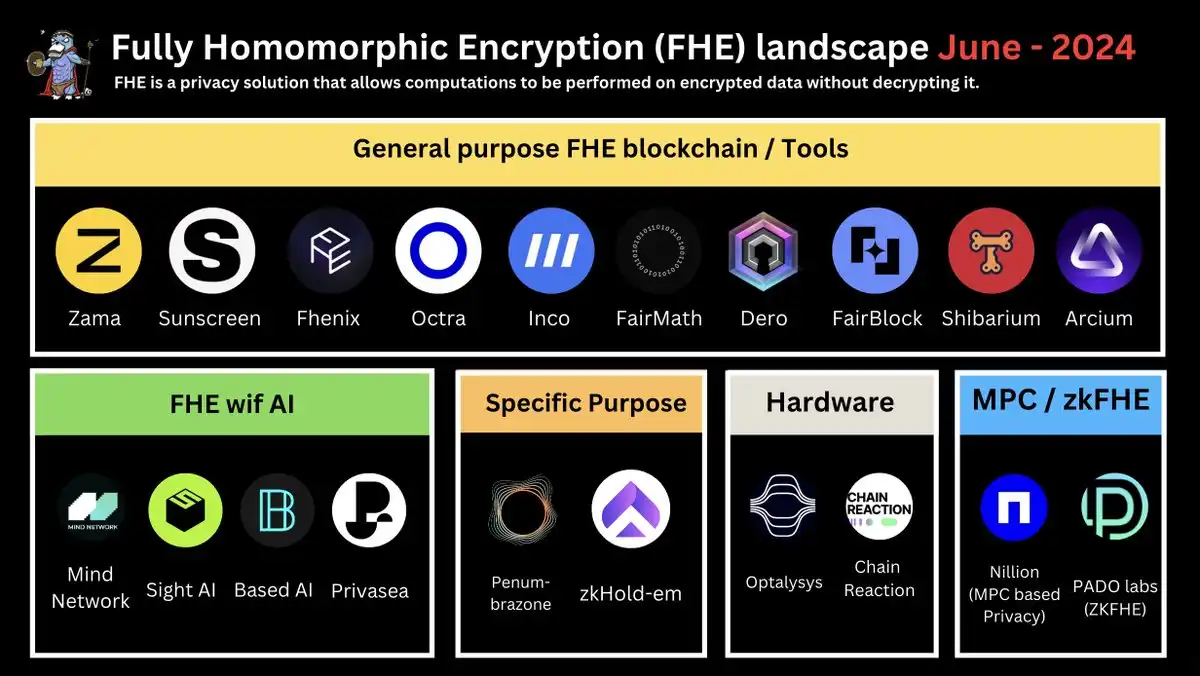
FHE پر پس منظر
FHE پہلی بار 1978 میں تجویز کیا گیا تھا، لیکن اس کی کمپیوٹیشنل پیچیدگی کی وجہ سے، یہ عملی نہیں تھا اور کافی عرصے سے نظریاتی تھا۔ یہ 2009 تک نہیں تھا کہ کریگ نے FHE کے لیے ایک قابل عمل ماڈل تیار کیا، جس نے FHE میں لوگوں کی تحقیقی دلچسپی کو جنم دیا۔
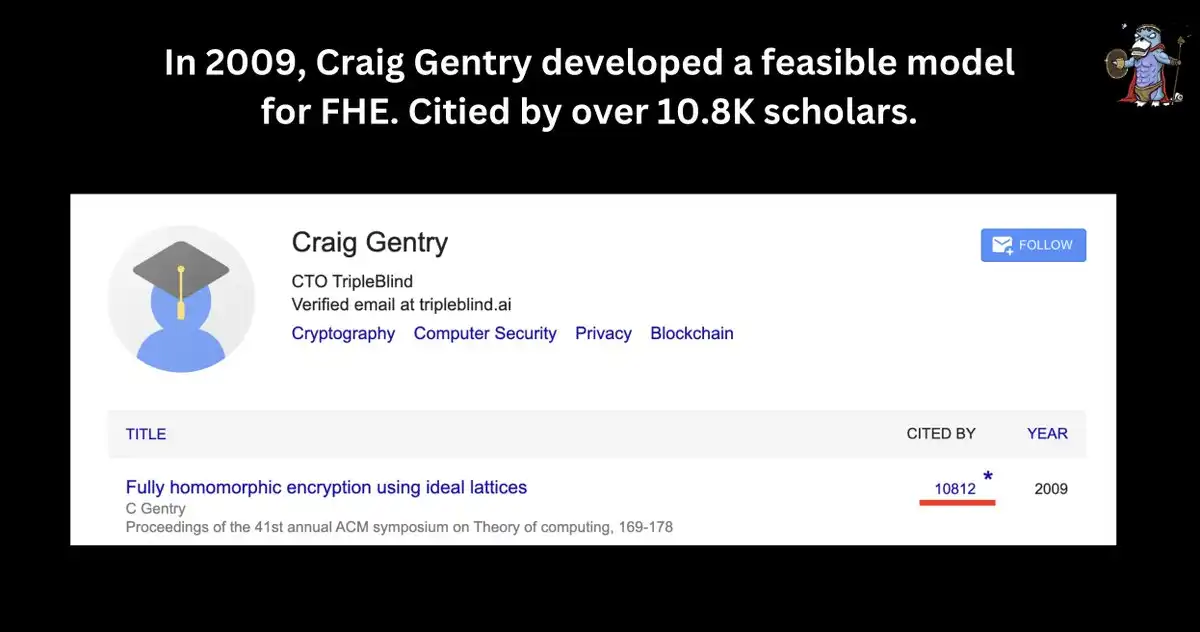
2020 میں، Zama نے TFHE اور fhEVM کا آغاز کیا، جس سے FHE کو کرپٹو کرنسی کی جگہ پر روشنی میں لایا گیا۔ تب سے، ہم نے یونیورسل EVM سے مطابقت رکھنے والے FHE L1/L2 (جیسے Fhenix، Inco) اور FHE کمپائلرز (جیسے سن اسکرین وغیرہ) کا ظہور دیکھا ہے۔
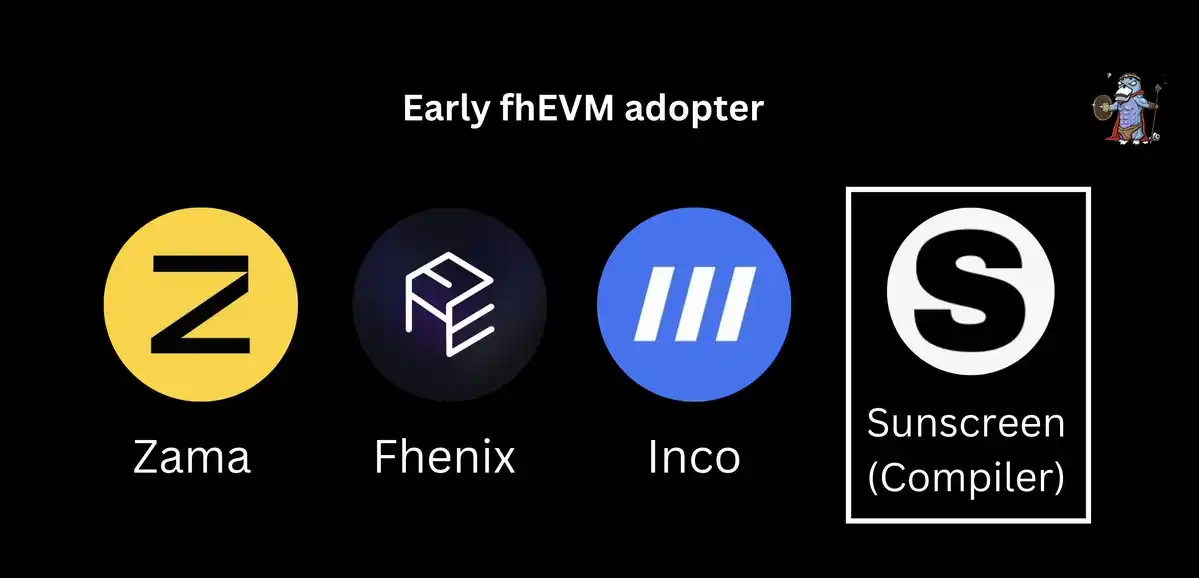
FHE کیسے کام کرتا ہے؟
آپ ایک اندھے خانے کا تصور کر سکتے ہیں جس کے اندر ایک پہیلی ہے۔ تاہم، نابینا باکس آپ کے دیے گئے پہیلی کے بارے میں کچھ نہیں جان سکتا، لیکن پھر بھی وہ ریاضی کے حساب سے نتیجہ نکال سکتا ہے۔
اگر یہ 鈥檚 بہت خلاصہ ہے، تو آپ FHE کی میری سادہ وضاحت سے مزید جان سکتے ہیں۔ FHE ایک پرائیویسی ٹیکنالوجی ہے جو خفیہ کردہ ڈیٹا کو پہلے ڈکرپٹ کیے بغیر اس پر کمپیوٹیشن کرنے کی اجازت دیتی ہے۔ دوسرے لفظوں میں، کوئی بھی تیسرا فریق یا کلاؤڈ حساس معلومات کو اندر موجود کسی بھی ڈیٹا تک رسائی کے بغیر پروسیس کر سکتا ہے۔
تو FHE کے استعمال کے کیسز کیا ہیں؟ ZKP اور MPC کے ذریعے مشین لرننگ، کلاؤڈ کمپیوٹنگ، آن چین جوئے کے لیے بہتر رازداری۔ پرائیویٹ آن چین ٹرانزیکشنز/پرائیویٹ سمارٹ کنٹریکٹس/پرائیویسی فوکسڈ ورچوئل مشینیں جیسے FHEVM وغیرہ۔
FHE کے استعمال کے کچھ معاملات میں شامل ہیں: پرائیویٹ آن چین کمپیوٹیشن، آن چین ڈیٹا انکرپشن، پبلک نیٹ ورکس پر پرائیویٹ سمارٹ کنٹریکٹس، خفیہ ERC 20، پرائیویٹ ووٹنگ، NFT بلائنڈ نیلامی، زیادہ محفوظ MPC، فرنٹ رننگ پروٹیکشن، ٹرسٹ لیس پل۔
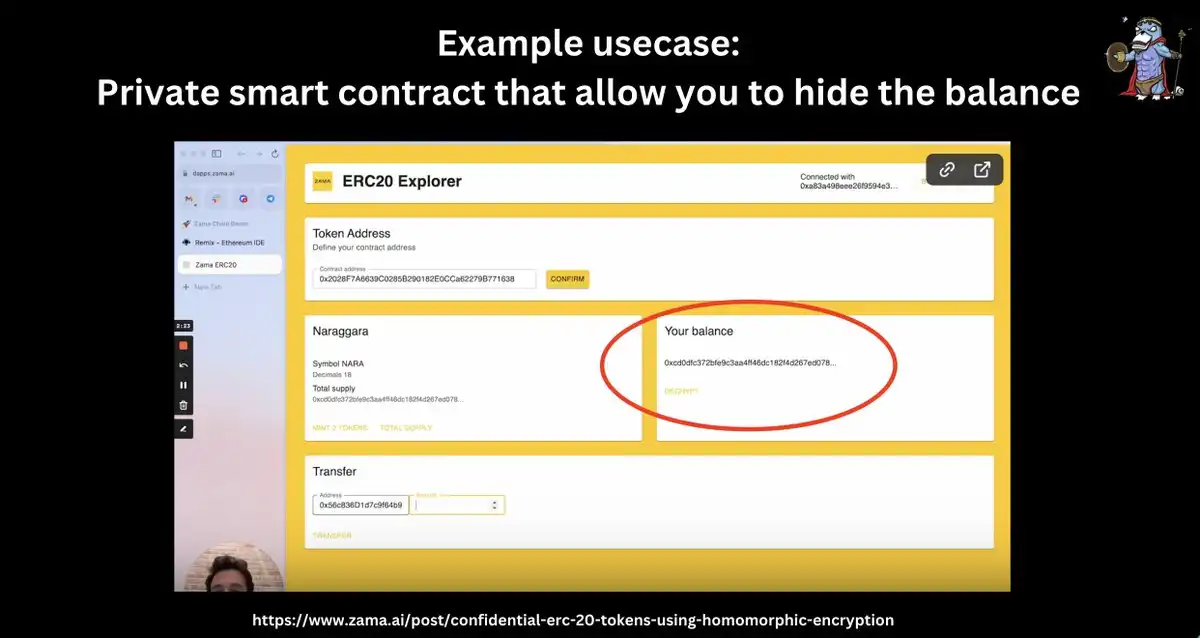
ایف ایچ ای ایکو سسٹم
عام طور پر، آن چین FHE کے امکانات کا خلاصہ پانچ شعبوں میں کیا جا سکتا ہے: عام FHE، FHE/HE مخصوص استعمال کے معاملات (ایپلی کیشنز)، FHE ایکسلریٹڈ ہارڈ ویئر، FHE Wif AI، اور متبادل حل۔
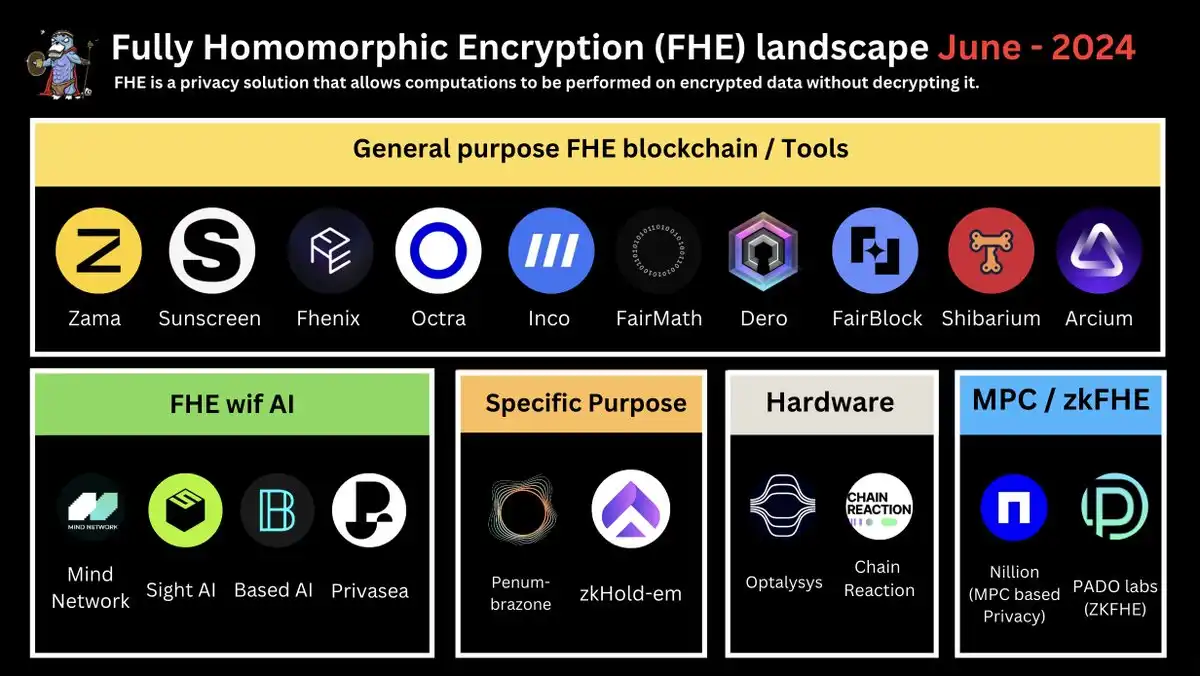
عام FHE بلاکچینز اور ٹولز
وہ بلاکچین رازداری کے حصول کے لیے ریڑھ کی ہڈی ہیں۔ اس میں SDK، coprocessor، compiler، new execution Environment، blockchain، FHE ماڈیول شامل ہیں… سب سے زیادہ چیلنج ایف ایچ ای کو EVM میں متعارف کروانا ہے، یعنی fhEVM۔

fhEVM:
زمانہ ( @zama_fhe )، fhEVM کے نمائندے کے طور پر – TFHE (مکمل طور پر ہومومورفک انکرپشن) + fhEVM (مکمل طور پر ہومومورفک ورچوئل مشین) حل فراہم کرنے والا پہلا فراہم کنندہ۔
فینکس ( @FhenixIO )، ETH پر FHE L2 (دوسری پرت) + FHE کاپروسیسر نافذ کرتا ہے۔
انکو نیٹ ورک ( @inconetwork )، گیمنگ/RWA (حقیقی دنیا کے اثاثے)/DID (وکندریقرت شناخت)/سوشل جیسے شعبوں میں EVM سے مطابقت رکھنے والے FHE L1 پر توجہ مرکوز کرنا۔
FairMath ( @FairMath )، ایک مکمل ہومومورفک ورچوئل مشین (FHE-(E)VM) تحقیقی تنظیم جو اوپن ایف ایچ ای کے ساتھ کام کر رہی ہے تاکہ FHE کے نفاذ اور اسے اپنانے کو فروغ دے سکے۔
FHE انفراسٹرکچر ٹولز:
اوکٹرا نیٹ ورک ( @octra )، ایک بلاکچین جو HFHE (ہائی آرڈر مکمل طور پر ہومومورفک انکرپشن) کو الگ تھلگ عملدرآمد کے ماحول کی حمایت کرتا ہے۔
سن اسکرین ( @SunscreenTech )، Rust پر مبنی مکمل طور پر ہومومورفک کمپائلر، Microsofts SEAL لائبریری پر انحصار کرتا ہے۔
فیئر بلاک ( @0x فیئر بلاک )، قابل پروگرام انکرپشن اور مشروط ڈکرپشن سروسز فراہم کرنے والا، tFHE (تھریشولڈ مکمل طور پر ہومومورفک انکرپشن) کو بھی سپورٹ کرتا ہے۔
ڈیرو ( @DeroProject )، نجی لین دین کے لیے HE (ہومومورفک انکرپشن) سپورٹ کے ساتھ L1 (FHE نہیں)۔
آرکیئم ( @ArciumHQ ) کے ذریعہ تیار کردہ @elusivprivacy ٹیم، ایک L1 ہے جو HE (ہومومورفک انکرپشن) + MPC (ملٹی پارٹی کمپیوٹیشن) + ZK (زیرو نالج پروف) رازداری کو یکجا کرتی ہے۔
Shibraum FHE چین، FHE L1 Zama TFHE حل کے ساتھ بنایا گیا ہے۔
FHE/HE مخصوص درخواستوں کے لیے
Penumbrazone ( @penumbrazone ): ایک کراس چین Cosmos dex (appchain) جو tFHE کو اپنے شیلڈ ایکسچینج/پول کے طور پر استعمال کرتا ہے۔
zkHold-em ( @zkHoldem ): مانٹا پر ایک پوکر گیم ہے جو کھیل کی انصاف پسندی کو ثابت کرنے کے لیے HE اور ZKP کا استعمال کرتا ہے۔
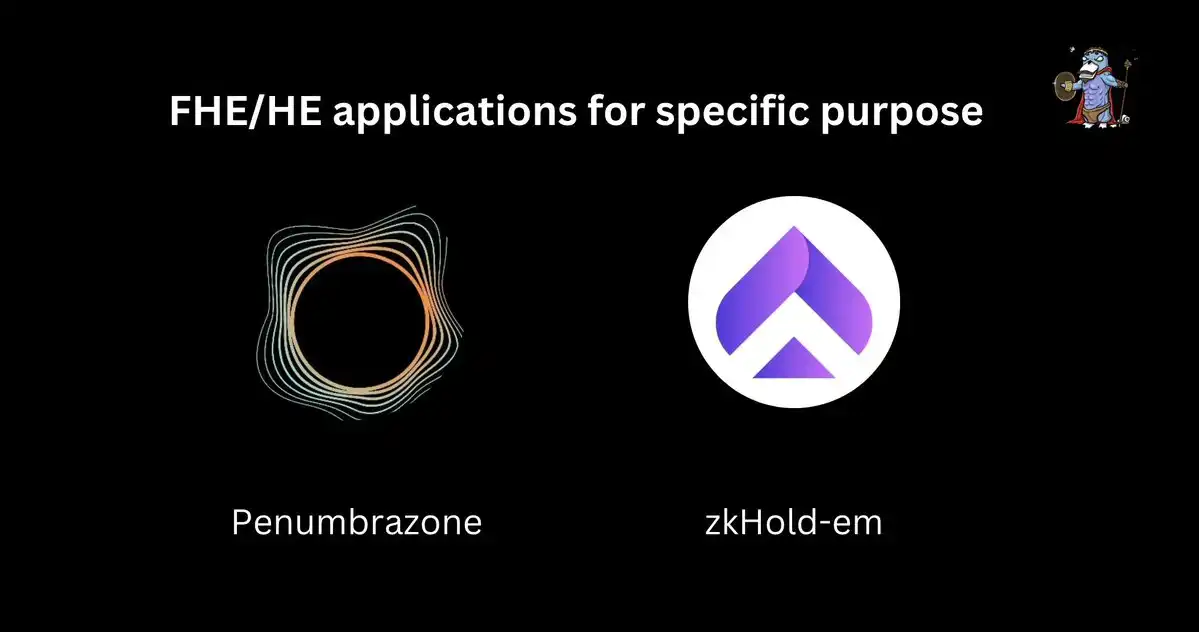
ہارڈ ویئر کی تیز رفتار FHE
جب بھی FHE کو FHE-ML جیسے گہرے حساب کے لیے استعمال کیا جاتا ہے، شور کی افزائش کو کم کرنے کے لیے بوٹسٹریپ کرنا بہت ضروری ہے۔ ہارڈویئر ایکسلریشن جیسے حل بوٹسٹریپنگ کو آسان بنانے میں اہم کردار ادا کرتے ہیں، ASICs بہترین کارکردگی کا مظاہرہ کر رہے ہیں۔
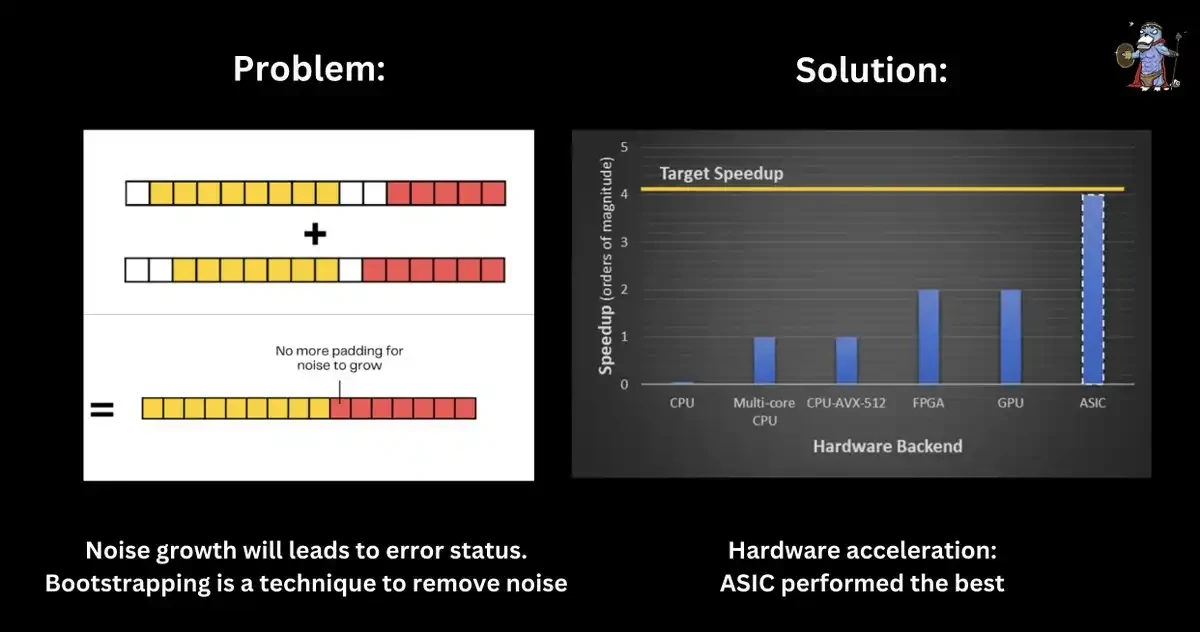
آپٹالیسیس ( @Optalysys )، ایک ہارڈویئر کمپنی نے آپٹیکل کمپیوٹنگ کے ذریعے TEE سے متعلقہ تمام سافٹ ویئر، بشمول FHE، کو تیز کرنے پر توجہ مرکوز کی۔
سلسلہ رد عمل ( @chainreactioni0 )، ایک ہارڈویئر کمپنی جو چپس بناتی ہے جو کان کنی کو زیادہ موثر بنانے میں مدد کرتی ہے۔ وہ 2024 کے آخر تک ایک FHE چپ لانچ کرنے کا ارادہ رکھتے ہیں۔
انگونیاما ( @Ingo_zk ) ایک سیمی کنڈکٹر کمپنی ہے جو ZKP/FHE ہارڈویئر ایکسلریشن پر فوکس کرتی ہے۔ موجودہ مصنوعات میں ZPU شامل ہے۔
سسک ( @cysic_xyz ) ایک ہارڈویئر ایکسلریشن کمپنی ہے جس کی موجودہ مصنوعات میں خود تیار کردہ FPGA ہارڈویئر کے ساتھ ساتھ آنے والی ZK DePiN چپ، ZK Air اور ZK Pro شامل ہیں۔
ہر کمپنی ہارڈ ویئر تیار کرنے میں مہارت رکھتی ہے جیسے کہ چپس، ASICs، اور سیمی کنڈکٹرز جو FHE کے بوٹ/کمپیوٹیشن کو تیز کر سکتے ہیں۔
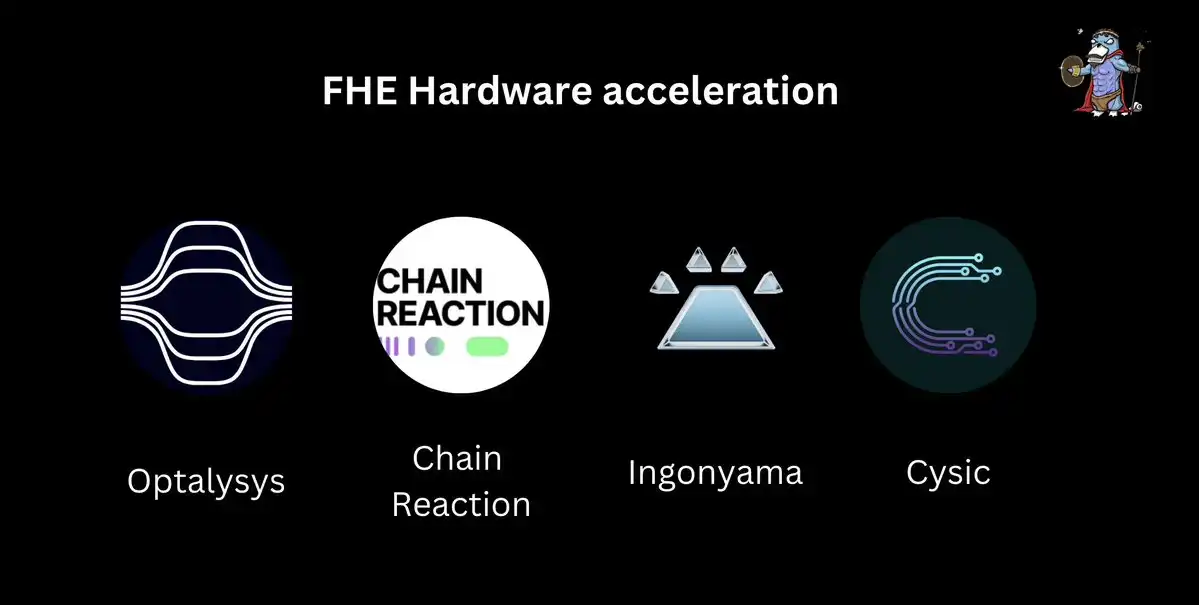
AI X FHE
حال ہی میں، FHE کو AI/ML میں ضم کرنے میں دلچسپی بڑھ رہی ہے، جہاں FHE مشینوں کو کسی بھی حساس معلومات کو پروسیسنگ کے دوران سیکھنے سے روک سکتا ہے اور پورے عمل کے دوران ڈیٹا، ماڈلز اور آؤٹ پٹس کے لیے رازداری فراہم کر سکتا ہے۔
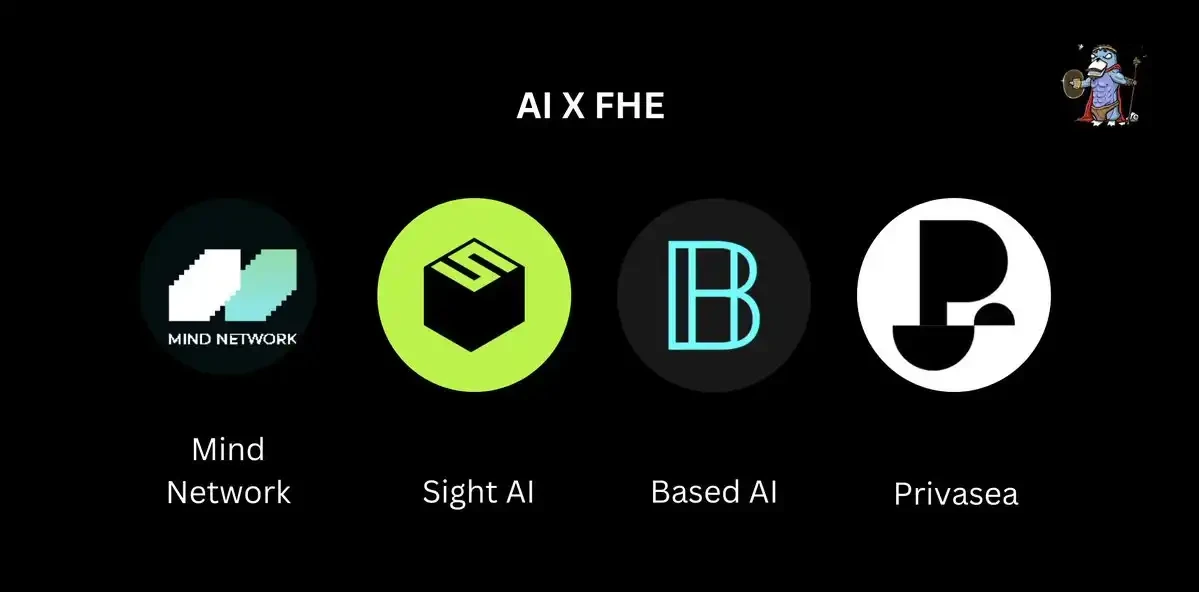
Ai x FHE ممبران میں شامل ہیں:
دماغی نیٹ ورک ( @mindnetwork_xyz )، ہائی ویلیو ڈیٹا انکرپشن اور پرائیویٹ ووٹنگ کے ذریعے پروف آف اسٹیک (PoS) اور AI نیٹ ورکس کو محفوظ کرنے کے لیے ایک FHE ری اسٹیکنگ پرت، نوڈ کی ملی بھگت اور ہیرا پھیری کے مواقع کو کم کرتی ہے۔
SightAl ( @theSightAI )، قابل تصدیق FHE-ML کے ساتھ ایک قابل تصدیق FHE AI انفرنس بلاکچین۔ بلاکچین تین اہم حصوں پر مشتمل ہے: سائیٹ چین، ڈیٹا ایگریگیشن لیئر (DA لیئر) اور ایک سائیٹ انفرنس نیٹ ورک، جہاں FHE-ML کام انجام دیئے جاتے ہیں۔
AI پر مبنی ( @getbasedai ) پر مبنی AI ایک L1 بلاکچین ہے جو FHE کو بڑے لینگویج ماڈلز (LLMs) کے ساتھ ضم کرتا ہے جس کا نام Cerberus Squeezing ہے، جو کسی بھی LLM کو ایک انکرپٹڈ زیرو نالج لارج لینگویج ماڈل (ZL-LLM) میں تبدیل کر سکتا ہے۔
Privasea Al ( @Privasea_ai )، Privasea AI ایک AI نیٹ ورک ہے جو صارفین کو HESea لائبریری میں FHE اسکیم کا استعمال کرتے ہوئے اپنے ڈیٹا یا ماڈلز کو خفیہ کرنے کی اجازت دیتا ہے اور پھر انہیں Privasea-AI نیٹ ورک پر اپ لوڈ کرتا ہے جہاں بلاکچین ڈیٹا کو انکرپٹڈ حالت میں پروسیس کرتا ہے۔
HESea لائبریری جامع ہے، TFHE، CKKS، اور BGV/BFV کے لیے مختلف لائبریریوں پر مشتمل ہے، اور مختلف اسکیموں کے ساتھ مطابقت رکھتی ہے۔
متبادل حل PC/ZKFHE
کچھ FHE استعمال نہیں کرتے ہیں، لیکن MPC کا استعمال اعلی قدر والے ڈیٹا کی حفاظت کے لیے کرتے ہیں اور اندھا حساب کتاب کرتے ہیں، جب کہ دیگر ZKSNARK کا استعمال کرتے ہیں تاکہ انکرپٹڈ ڈیٹا پر FHE حسابات کی درستگی کو یقینی بنایا جا سکے۔ وہ ہیں:
نیلین نیٹ ورک ( @nillionnetwork )، ایک کمپیوٹنگ نیٹ ورک جو MPC کا استعمال کرتا ہے ڈی سینٹرلائز اور ہائی ویلیو ڈیٹا کو ذخیرہ کرنے کے لیے، جبکہ صارفین کو پروگرام لکھنے اور بلائنڈ کمپیوٹیشن کرنے کی اجازت دیتا ہے۔ نیلین دو اہم اجزاء پر مشتمل ہے: کوآرڈینیشن لیئر اور پیٹ نیٹ۔ کوآرڈینیشن پرت ادائیگی کے چینل کے طور پر کام کرتی ہے، جب کہ پیٹ نیٹ بلائنڈ کمپیوٹیشن اور ہائی ویلیو ڈیٹا کا ذخیرہ کرتا ہے۔
پاڈولابس ( @padolabs )، Pado ایک کمپیوٹنگ نیٹ ورک ہے جو FHE استعمال کرتا ہے حساس ڈیٹا کو پروسیس کرنے کے لیے، جبکہ MPC-TLS اور ZKP کا فائدہ اٹھاتے ہوئے کمپیوٹنگ کی درستگی کو یقینی بناتا ہے۔
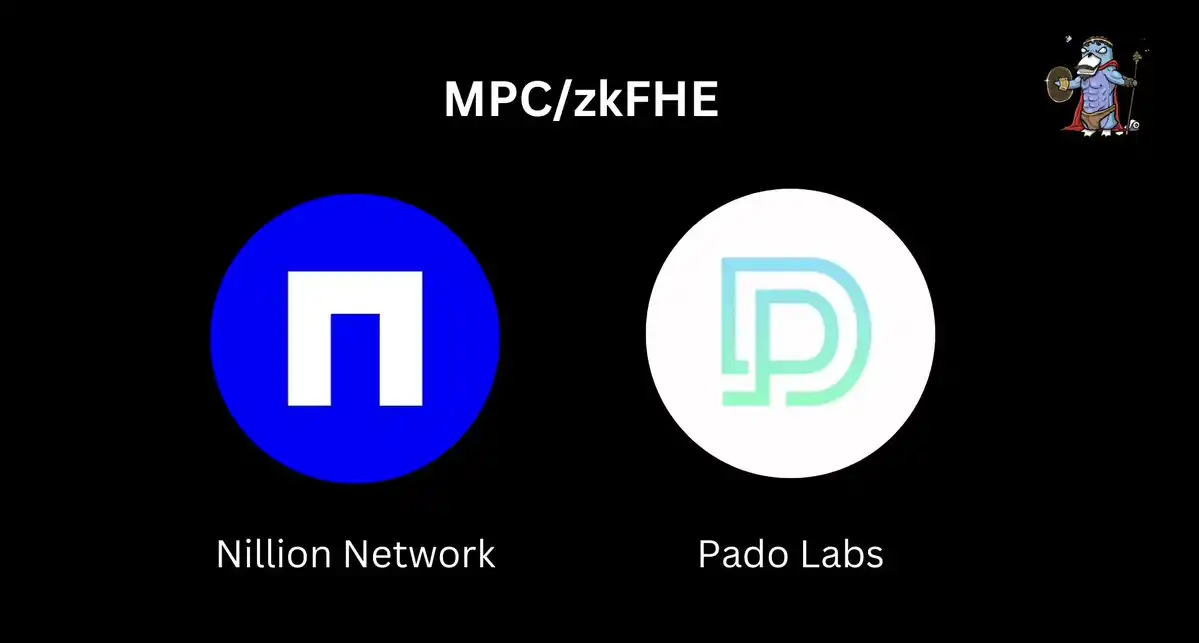
FHE چیلنجز اور حل
ZK اور MPC کے برعکس، FHE اب بھی اپنے ابتدائی مراحل میں ہے۔ اب ایف ایچ ای کی کیا رکاوٹ ہے؟ حساب کی حفاظت کو بڑھانے کے لیے، خفیہ کاری کے دوران سائفر ٹیکسٹ میں کچھ شور شامل کیا جاتا ہے۔ جب سائفر ٹیکسٹ میں بہت زیادہ شور جمع ہوتا ہے، تو یہ بہت زیادہ شور بن جاتا ہے اور آخر کار آؤٹ پٹ کی درستگی کو متاثر کرتا ہے۔ مختلف حل تلاش کر رہے ہیں کہ کس طرح ڈیزائن پر بہت زیادہ پابندیاں عائد کیے بغیر شور کو مؤثر طریقے سے ختم کیا جائے، بشمول TFHE، CKKS، BGV، وغیرہ۔
FHE کے اہم چیلنجز میں شامل ہیں:
سست کارکردگی: فی الحال، fh-EVM استعمال کرنے والے نجی سمارٹ کنٹریکٹس میں صرف 5 TPS ہیں۔ خالص ڈیٹا کے مقابلے، TFHE اب تقریباً 1000 گنا سست ہے۔
ابھی تک ڈویلپرز کے لیے موزوں نہیں: معیاری الگورتھم اور مجموعی طور پر تعاون یافتہ FHE ٹولز کی کمی ہے۔
ہائی کمپیوٹیشنل اوور ہیڈ (لاگت): یہ شور کے انتظام اور پیچیدہ کمپیوٹنگ بوٹسٹریپنگ کی وجہ سے نوڈ سنٹرلائزیشن کا باعث بن سکتا ہے۔
غیر محفوظ زنجیروں پر FHE کے خطرات: کسی بھی تھریشولڈ ڈکرپشن سسٹم کی حفاظت کو یقینی بنانے کے لیے، ڈکرپشن کیز کو نوڈس میں تقسیم کیا جاتا ہے۔ تاہم، ایف ایچ ای کے اوور ہیڈ کی وجہ سے، اس سے توثیق کرنے والوں کی بہت کم تعداد ہو سکتی ہے اور اس وجہ سے ملی بھگت کا زیادہ امکان ہے۔
حل میں شامل ہیں:
پروگرام ایبل بوسٹ: یہ حسابات کو بوٹ کے دوران لاگو کرنے کی اجازت دیتا ہے، اس طرح ایپلی کیشن مخصوص ہونے کے دوران کارکردگی کو بہتر بناتا ہے۔
ہارڈ ویئر ایکسلریشن: FHE کارکردگی کو تیز کرنے کے لیے OpenFHE لائبریری کے ساتھ ASICs، GPUs، اور FPGAs تیار کریں۔
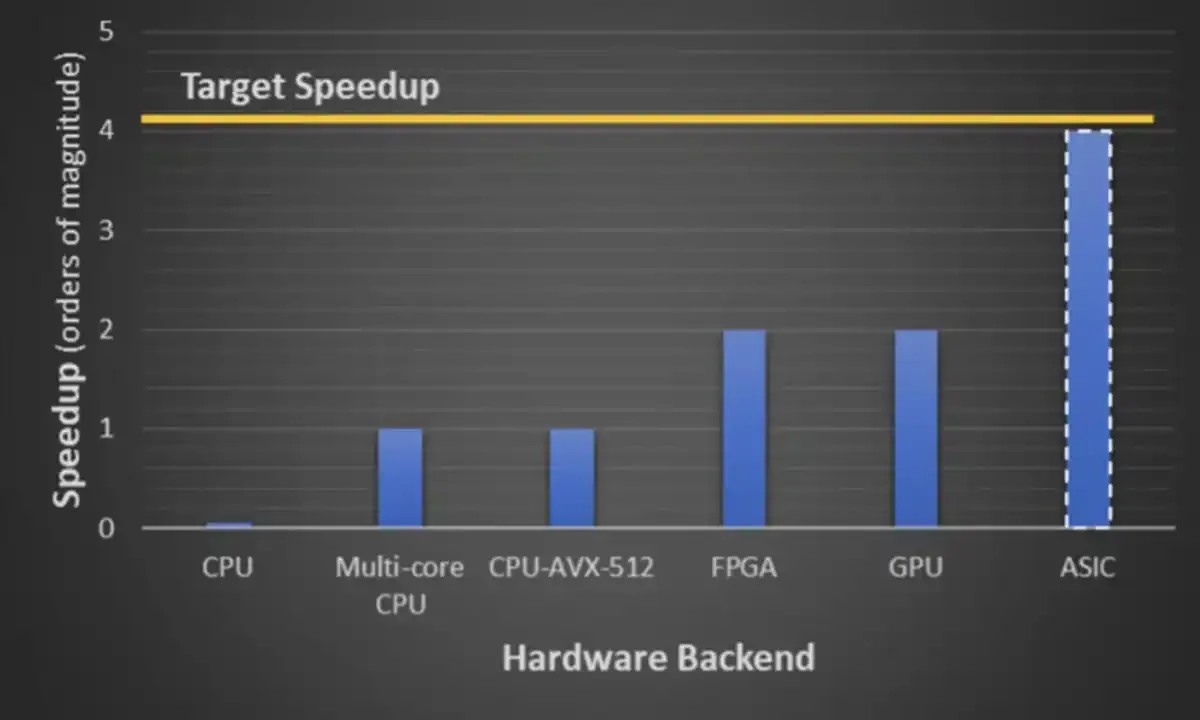
بہتر تھریشولڈ ڈکرپشن سسٹم۔ مختصراً، آن-چین FHE کو مزید محفوظ بنانے کے لیے، ہمیں ایک نظام کی ضرورت ہے (جو MPC ہو سکتا ہے) اس بات کو یقینی بنانے کے لیے: کم تاخیر؛ نوڈ میں داخلے کی رکاوٹوں کو کم کرنا اور وکندریقرت حاصل کرنا؛ غلطی کی رواداری.
یہ مضمون انٹرنیٹ سے حاصل کیا گیا ہے: VCs کی طرف سے گرمجوشی سے پیروی کی گئی، یہاں FHE ماحولیاتی نظام میں قابل توجہ منصوبے ہیں
اگلے ہفتوں کی جھلکیاں ZeroLend: ZERO TGE 6 مئی کو شروع کی جائے گی، جس میں ایئر ڈراپس کے لیے استعمال ہونے والی کل سپلائی کا 15%-17%؛ موڈ گورننس ٹوکن MODE کو 7 مئی کو جاری کرے گا اور ایئر ڈراپ ایپلی کیشنز کو کھولے گا۔ meson.network: مین نیٹ میپنگ 7 مئی کو ہونے والی ہے۔ EigenLayer 10 مئی کو ٹوکن کلیمز کھولنے کا ارادہ رکھتی ہے۔ فائدہ: ایئر ڈراپ ایپلی کیشنز کا پہلا مرحلہ ختم ہو گیا ہے، اور مزید متعلقہ معلومات کا اعلان اگلے ہفتے کیا جائے گا۔ 6 مئی سے 12 مئی تک، صنعت میں مزید قابل ذکر واقعات کا پیش نظارہ ذیل میں کیا گیا ہے۔ 6 مئی Horizen سے 6 مئی کو نیٹ ورک اپ گریڈ کرنے کی توقع ہے Odaily Planet Daily News Horizen اپنے نیٹ ورک کو بلاک کی اونچائی 1,554,150 پر اپ گریڈ کرے گا (6 مئی کو 11:00 بجے متوقع)۔ بائننس کے معطل ہونے کی توقع ہے…







